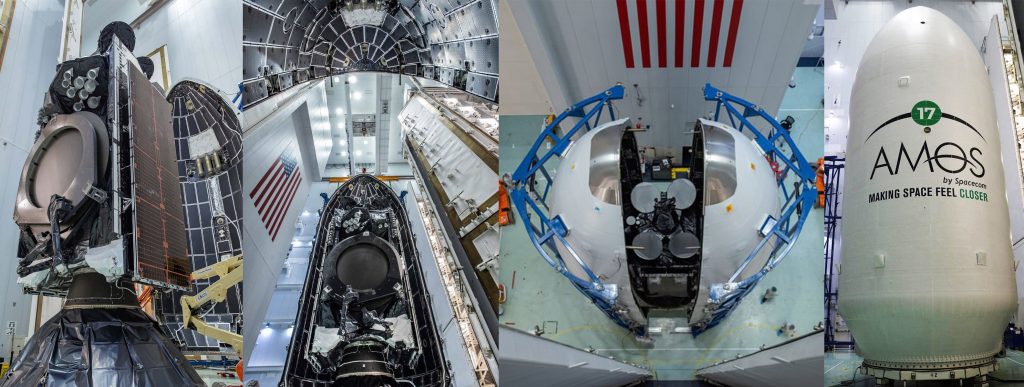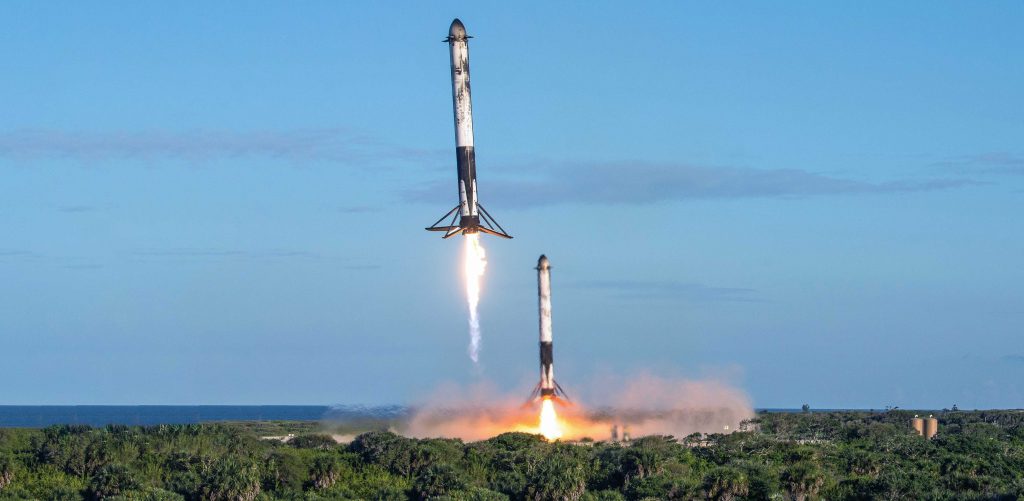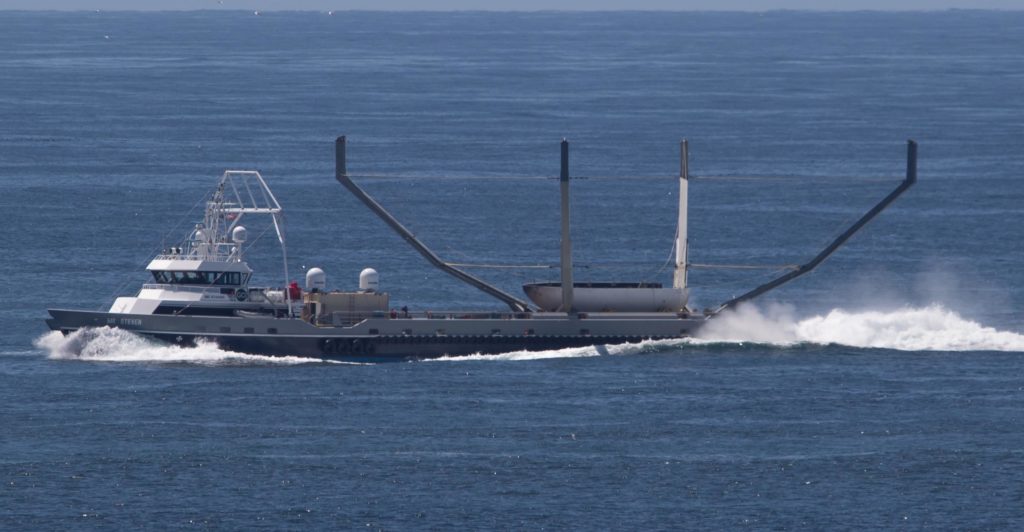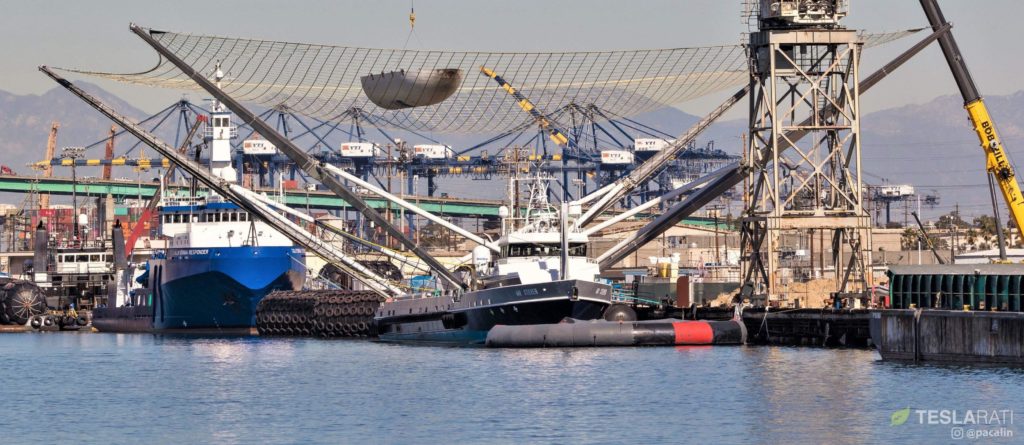In a telltale sign that SpaceX is growing much more confident in its ability to consistently recover Falcon 9 fairings, the company has accepted delivery of second recovery ship almost identical to GO Ms. Tree (formerly Mr. Steven) just days after nailing its second fairing catch in a row.
Previously known as M/V Captain Elliott, the new ship appears to have been acquired (or leased) by Guice Offshore (GO) from SEACOR Marine, who purchased Elliott from struggling marine services company Seatran Marine in 2017. One way or another, SpaceX now has a pair of Port Canaveral-based fairing recovery ships in hand – named Ms. Tree and Ms. Chief – and is thus making excellent progress towards catching and reusing both halves of the same Falcon 9 (or Heavy) fairing.
Splurging on ‘ships
Put simply, whoever is paying for or has paid for the two fast supply vessels (FSVs) that are now a part of SpaceX’s rocket recovery fleet has/had a tidy sum to spend. For ships as large, new, and high-performance as Ms. Tree and Ms. Chief, both completed in the mid-2010s, SpaceX or GO would be lucky to pay less than $10M apiece and each ship could easily cost more than $20M, depending on a variety of unknowns. Previous owner Seatran Marine is/was admittedly in dire financial straits, so that could have resulted in an effective fire-sale discount.
Regardless, this is to say that SpaceX was likely willing to splurge and open its wallet wide for extremely high-quality fairing recovery vessels because of just how expensive those fairings are. According to CEO Elon Musk circa 2017, it costs SpaceX $5-6M total to produce a set of Falcon fairing halves, equivalent to roughly 10% of the cost of a Falcon 9 launch ($50M-60M).

As an example, assume that SpaceX paid a full $50M for Ms. Tree and Ms. Chief – effectively a worst-case cost scenario. Assume that recovering and reusing net-caught Falcon fairings still costs half as much as building new fairings ($3M for two halves), also likely a worst-case scenario given the relative mechanical and propulsive simplicity of fairings.
In this mediocre-at-best scenario, it would still take SpaceX less than 20 launches with both halves recovered to completely recoup the cost of both fairing recovery ships. In the event that reusing caught fairings is only 25% as expensive as building new fairings, SpaceX could recoup its fleet investments in just 10 launches. In fact, cost reduction may even be a secondary consideration next to the potential for effectively doubling fairing production with the same facilities. From that perspective, spending, say, $50M on development and another $50M on cutting-edge recovery vessels could easily be a bargain, especially compared to the $1B+ SpaceX has spent deloping Falcon 9 booster reusability.

Fairing-catcher Mk4
With GO Ms. Chief’s August 10th arrival at Port Canaveral, SpaceX’s team of Florida-based recovery engineers and technicians will now be tasked with modifying the ship for Falcon fairing catching. SpaceX completed its first fairing recovery-focused modifications back in late 2017, likely producing what was the first version of fairing recovery tech (Mk1). The net proved to be far too small and was replaced in summer 2018 with a net and arms likely 4X larger (Mk2).


Roughly half a year and several missed catches after Mr. Steven’s Mk2 net was installed, the ship transited the Panama Canal and arrived at Port Canaveral in February 2019. Barely a week or two later, Mr. Steven suffered a failure at sea – well before a planned catch attempt – that saw the ship limp back to port missing the entirety of its net and two of four arms.
After another four months in port, SpaceX installed a third net and arms system on Mr. Steven, featuring distinct differences and apparent upgrades that likely make it Mk3. Shortly after installation and a quick renaming from Mr. Steven to GO Ms. Tree, Ms. Tree’s inaugural Mk3 recovery attempt culminated in SpaceX’s first and second successful fairing catches – back-to-back – on June 24th and August 6th.
Finally, this brings us to the blank slate that is GO Ms. Chief. Compared to Ms. Tree, both vessels are nearly identical: both are built by Gulf Craft, LLC, both are 205 ft x 34 ft (62m x 10m), both have decks rated for ~405 metric tons (900,000 lb), and have top speeds of 26-32 knots (30-37 mph, 50-60 km/h; fully-loaded vs. empty). The lone point of difference is power: Ms. Chief’s engines produce 500 more horsepower and its generators produce an additional 120 kW of power, respective improvements of 5% and 16% relative to Ms. Tree (Mr. Steven).
Despite both ships being nearly identical, SpaceX is unlikely to simply copy and paste Ms. Tree’s thus far successful arms and net, likely instead doing what the company is famous for and fabricating a new and improved variant of the fairing recovery mechanism. This would presumably translate to Mk4. Conveniently, SpaceX appears to be heading into a rare period of no launches, likely stretching almost three months from August 6th (AMOS-17) to late October.
If Mr. Steven and Ms. Tree’s transformations are anything to go by, that hefty chunk of time that should be more than sufficient to fully outfit Ms. Chief with a fresh fairing recovery mechanism, assuming SpaceX has been simultaneously fabricating the hardware in anticipation of Ms. Chief’s arrival.
For now, we’ll have to wait and see if SpaceX’s next launches – both believed to be 60-satellite Starlink missions – will mark the recovery debut of Ms. Chief, as well as the first attempted catch of both Falcon fairing halves. Additionally, following SpaceX’s second successful fairing half catch on August 6th, it’s possible that the company has two recovered halves capable of making a full, flight-proven fairing. Either way, a Starlink launch will likely support the flight-debut of a reused fairing and will almost certainly host the first attempted simultaneous recovery of both fairing halves.
Check out Teslarati’s newsletters for prompt updates, on-the-ground perspectives, and unique glimpses of SpaceX’s rocket launch and recovery processes.

<!–
–>
var disqus_shortname = «teslarati»;
var disqus_title = «SpaceX adds new ship to fleet after fairing catcher Ms. Tree nails second recovery in a row»;
var disqus_url = «https://www.teslarati.com/spacex-ms-tree-catch-second-fairing-recovery-ship/»;
var disqus_identifier = «teslarati-111510»;

